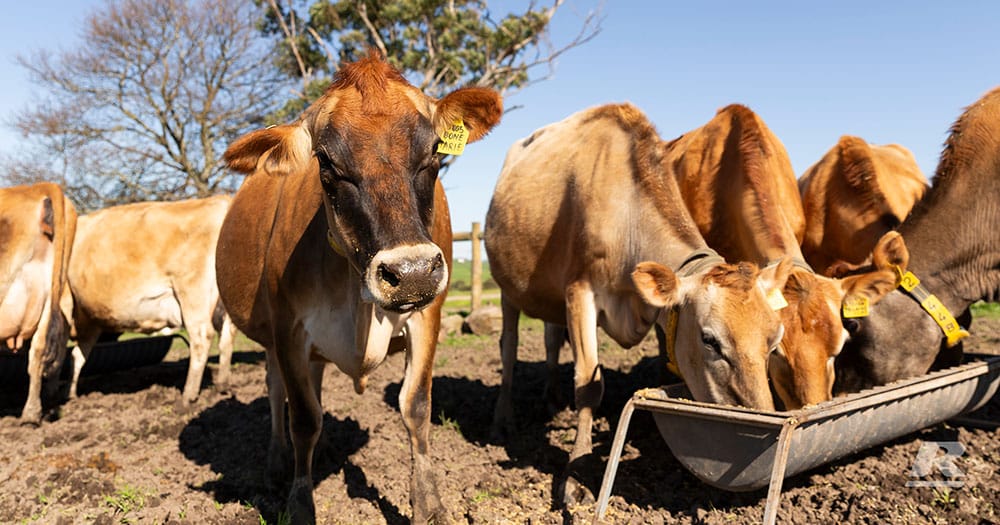Seasonal Feed Shortages
Why you should consider weaning your beef calves into confinement and/or onto a supplementary feed
The summer and autumn months more often than not pose a significant challenge for beef farmers in South Eastern Australia due to a shortage of “paddock feed”. During these warmer seasons, our predominately winter-active pastures often struggle to provide sufficient forage. It is often the feed during this period which farmers base their carrying capacity off or forces them to sell stock.
To overcome this there is a critical need for alternative feeding strategies to maintain herd health and productivity. Addressing these feed shortages is essential for sustainable farm management, increased productivity, profitability and the long-term viability of beef operations.
Calves can be weaned onto supplementary feed in a variety of ways the 2 most common ways are a total mixed ration (TMR) into feed troughs or using a grain lick feeder and baled fodder in feeders. Both systems can occur either in a fully-fledged containment pen or in a “sacrifice paddock”. TMR Systems offer greater control and flexibility over the diet but require more infrastructure, labour, and careful management. Whilst, the grain feeder and hay feeder system provide a simpler, more flexible feeding strategy with lower initial costs and labour demands, though has the potential for nutritional imbalances and less precise control over feed intake.
Here’s why you should consider either option when weaning your beef calves:
1) Reduced Weaning Stress
- Gradual Transition: Calves can be weaned more gradually, which can help reduce the stress associated with sudden separation from their mothers.
2) Better Nutrition Management & Calf Health Management
- Consistent and adequate Diet: Calves receive a balanced and consistent diet, which can be more easily monitored and adjusted to ensure optimal growth and health. Your local RSF rep can help you to best utilise home-grown and purchased fodder along with grain to provide a balanced diet to meet your growth expectations.
- Controlled Environment: Calves are less exposed to harsh weather conditions, which can reduce stress and the risk of illness.
- Close Observation: Confinement means calves are easier to monitor for signs of illness or stress as well as allowing for quick and easy intervention/treatment.
- Handling and Training: Confinement weaning can help calves get accustomed to human interaction and handling facilities, reducing stress during future handling.
- Health Records: Accurate health and growth recording is more feasible, aiding in long-term herd health management and decision-making.
3) Enhanced Growth Rates
- Improved Feed Efficiency: Calves in confinement often exhibit better feed conversion ratios (FCR’s) due to a consistent and high-quality diet.
- Faster Weight Gain: With controlled feeding, calves can achieve faster and more uniform weight gain.
4) Economic Benefits
- Higher FCR’s and better ADG’s: gives you more bang for your buck, created by lower stress, better animal health management and consistent nutrition.
- Potential for Higher Market Value: Calves that are weaned and preconditioned in confinement often bring higher prices at market due to their improved health, condition and uniform growth.
- Lower Mortality Rates: Reduced disease and stress levels can lead to lower mortality rates, enhancing overall herd productivity and profitability.
- Increased year-round stocking rate: the supplementary feeding of weaner calves reduces the forage required during periods of lowest pasture availability which allows you to increase the year-round stocking rate of the farm. Being able to maintain a higher stocking rate in the driest parts of the year you are able to better capture the excess growth in the late winter and spring. This improves your bottom line through an increase in dollars produced per hectare of land.
5) Pasture Management
- Pasture Management: Confining weaned calves allows pastures to recover, reducing overgrazing and improving long-term pasture health.
- Pasture Rest and Recovery
- Improved Grass Health: By removing animals from pastures, grasses have time to rest and regrow, improving their health and vigour. This recovery period is essential for maintaining pastures as it allows grass root systems to develop deeper and stronger, which enhances drought resistance and overall pasture resilience.
- Enhanced Forage Production
- Increased Forage Yield: Allowing pastures to rest and regrow to the 3 leaf stage prior to grazing can lead to increased forage production in subsequent seasons.
- Weed Control
- Reduced Weed Encroachment: during the drier months cattle often overgraze the desirable plants, allowing weed growth due to a lack of competition. Resting pastures can reduce weed encroachment by allowing desirable plants to outcompete weeds.
- Soil Health Improvement
- Soil Structure Maintenance through reduced compaction: Continuous grazing can compact soil, reducing its aeration and water infiltration capacity.
- Nutrient Cycling: Manure and plant material decomposition during rest periods contribute to nutrient cycling, enhancing soil fertility and productivity.
- Reduced Erosion: Adequate ground cover from healthy vegetation protects the soil surface from erosive forces
- Drought Mitigation: Well-rested pastures are more resilient to drought conditions, as they have better root systems and soil health, which helps retain moisture.
- Sustainable Pasture Management
- Long-term Productivity: Implementing periods of rest through confinement feeding supports sustainable pasture management practices, ensuring long-term productivity and profitability.
- Rotational Grazing Compatibility: Confinement feeding can be integrated into rotational grazing systems using “on-off grazing” techniques common in the dairy industry this optimises pasture use and recovery.
Addressing these feed shortages is essential for sustainable farm management, increased productivity, profitability and the long-term viability of beef operations.
For tailored guidance on enhancing your herd’s nutrition and management practices, turn to the specialists at Reid Stockfeeds. We’re dedicated to empowering you with expert advice to support the health and performance of your cows. Contact us today to discover our extensive selection of high-quality feed options and explore customised solutions designed to meet your farm’s unique needs.. Call 1300 REID FEED or enquire here >
Author
Tom Fitzgerald
Sales & Nutrition Account Manager
